traction control BMW 7 SERIES 2014 F02 User Guide
[x] Cancel search | Manufacturer: BMW, Model Year: 2014, Model line: 7 SERIES, Model: BMW 7 SERIES 2014 F02Pages: 265, PDF Size: 5.68 MB
Page 150 of 265
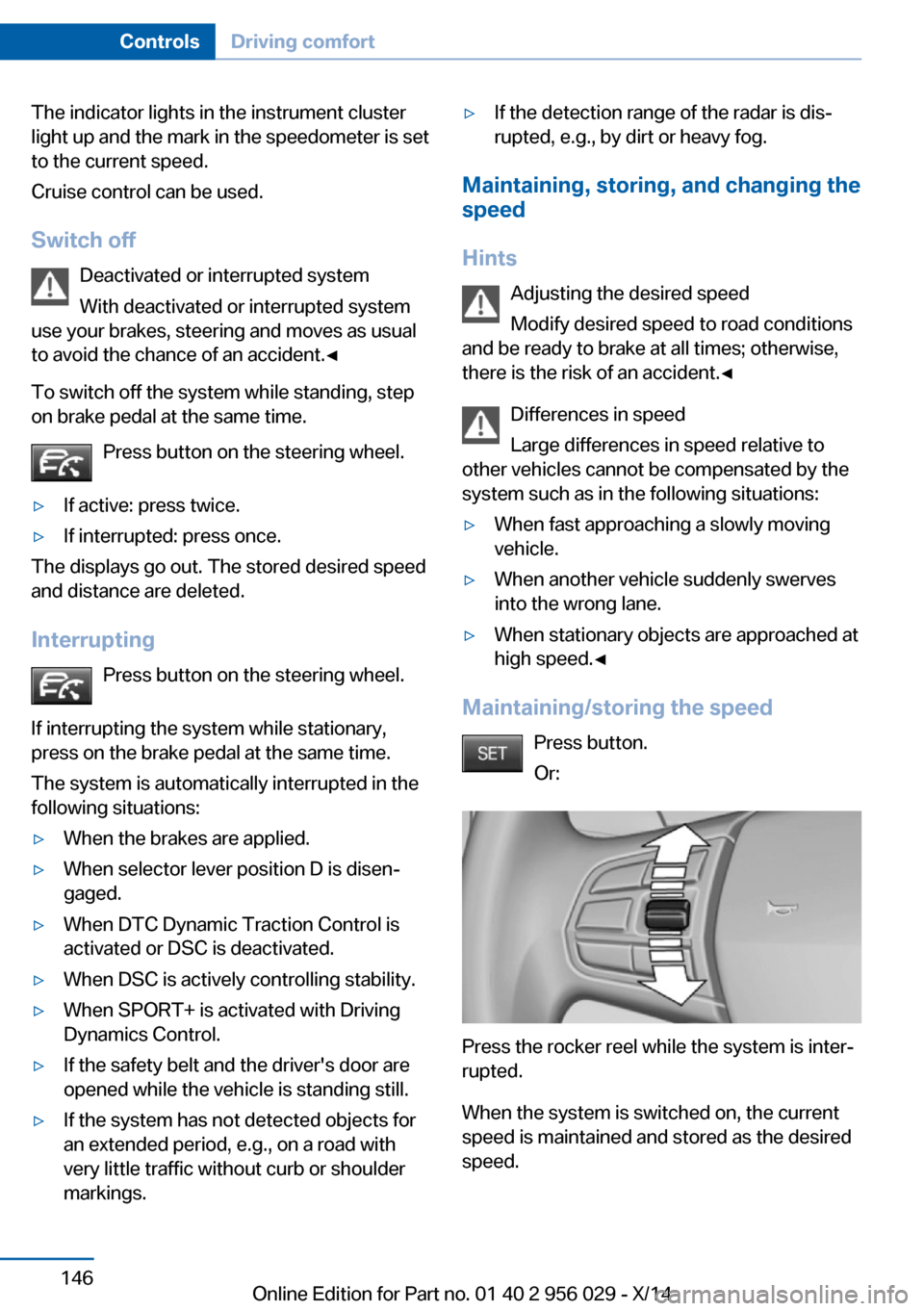
The indicator lights in the instrument cluster
light up and the mark in the speedometer is set
to the current speed.
Cruise control can be used.
Switch off Deactivated or interrupted system
With deactivated or interrupted system
use your brakes, steering and moves as usual
to avoid the chance of an accident.◀
To switch off the system while standing, step
on brake pedal at the same time.
Press button on the steering wheel.▷If active: press twice.▷If interrupted: press once.
The displays go out. The stored desired speed
and distance are deleted.
Interrupting Press button on the steering wheel.
If interrupting the system while stationary,
press on the brake pedal at the same time.
The system is automatically interrupted in the
following situations:
▷When the brakes are applied.▷When selector lever position D is disen‐
gaged.▷When DTC Dynamic Traction Control is
activated or DSC is deactivated.▷When DSC is actively controlling stability.▷When SPORT+ is activated with Driving
Dynamics Control.▷If the safety belt and the driver's door are
opened while the vehicle is standing still.▷If the system has not detected objects for
an extended period, e.g., on a road with
very little traffic without curb or shoulder
markings.▷If the detection range of the radar is dis‐
rupted, e.g., by dirt or heavy fog.
Maintaining, storing, and changing the
speed
Hints Adjusting the desired speedModify desired speed to road conditions
and be ready to brake at all times; otherwise,
there is the risk of an accident.◀
Differences in speed
Large differences in speed relative to
other vehicles cannot be compensated by the
system such as in the following situations:
▷When fast approaching a slowly moving
vehicle.▷When another vehicle suddenly swerves
into the wrong lane.▷When stationary objects are approached at
high speed.◀
Maintaining/storing the speed
Press button.
Or:
Press the rocker reel while the system is inter‐
rupted.
When the system is switched on, the current
speed is maintained and stored as the desired
speed.
Seite 146ControlsDriving comfort146
Online Edition for Part no. 01 40 2 956 029 - X/14
Page 155 of 265
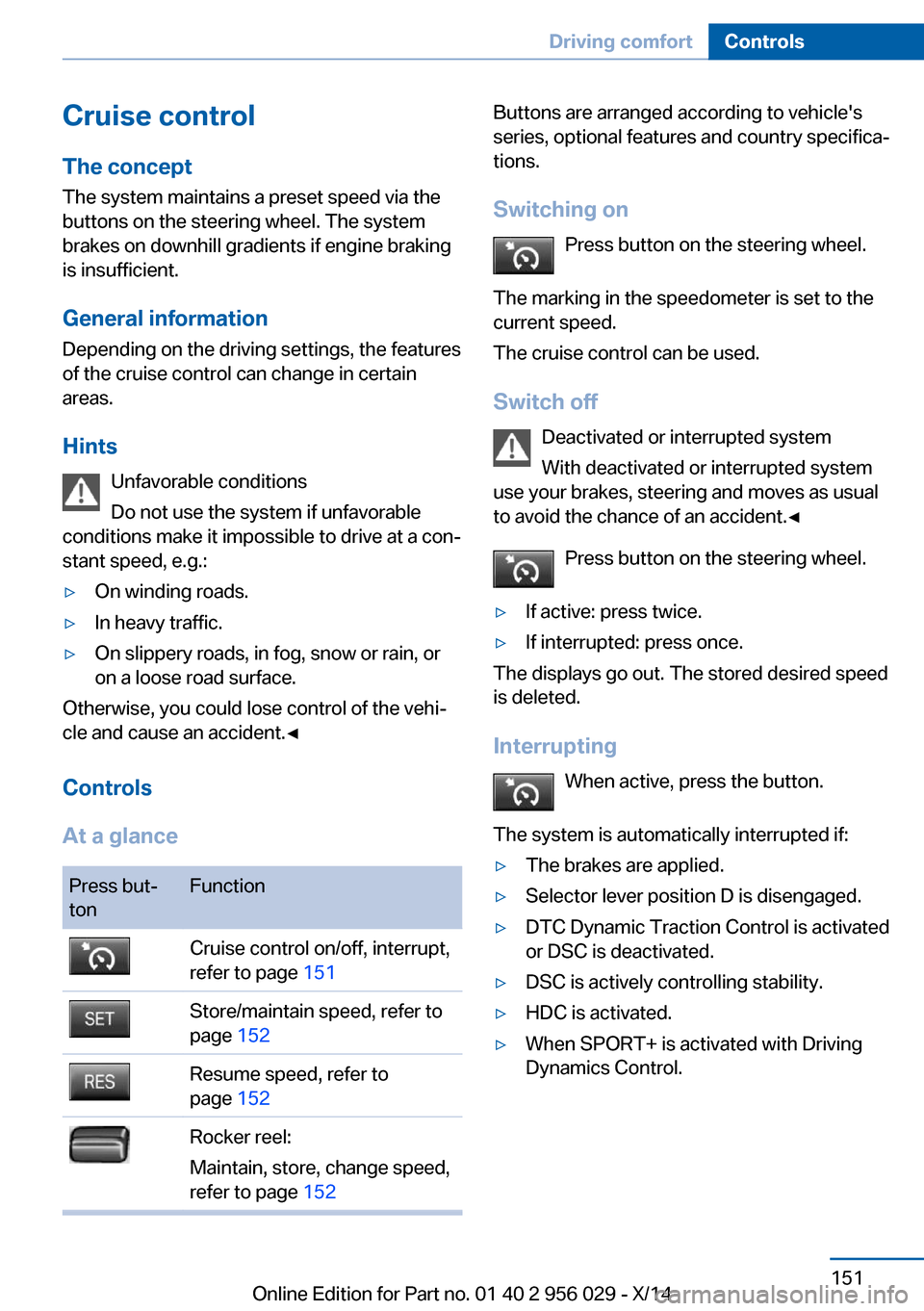
Cruise controlThe concept The system maintains a preset speed via the
buttons on the steering wheel. The system
brakes on downhill gradients if engine braking
is insufficient.
General information
Depending on the driving settings, the features
of the cruise control can change in certain
areas.
Hints Unfavorable conditions
Do not use the system if unfavorable
conditions make it impossible to drive at a con‐
stant speed, e.g.:▷On winding roads.▷In heavy traffic.▷On slippery roads, in fog, snow or rain, or
on a loose road surface.
Otherwise, you could lose control of the vehi‐
cle and cause an accident.◀
Controls
At a glance
Press but‐
tonFunctionCruise control on/off, interrupt,
refer to page 151Store/maintain speed, refer to
page 152Resume speed, refer to
page 152Rocker reel:
Maintain, store, change speed,
refer to page 152Buttons are arranged according to vehicle's
series, optional features and country specifica‐
tions.
Switching on Press button on the steering wheel.
The marking in the speedometer is set to the
current speed.
The cruise control can be used.
Switch off Deactivated or interrupted system
With deactivated or interrupted system
use your brakes, steering and moves as usual
to avoid the chance of an accident.◀
Press button on the steering wheel.▷If active: press twice.▷If interrupted: press once.
The displays go out. The stored desired speed
is deleted.
Interrupting When active, press the button.
The system is automatically interrupted if:
▷The brakes are applied.▷Selector lever position D is disengaged.▷DTC Dynamic Traction Control is activated
or DSC is deactivated.▷DSC is actively controlling stability.▷HDC is activated.▷When SPORT+ is activated with Driving
Dynamics Control.Seite 151Driving comfortControls151
Online Edition for Part no. 01 40 2 956 029 - X/14
Page 200 of 265

Adjusting fuel consumption historytime frame
Select the symbol.
Resetting fuel consumption history
1.Open "Options".2."Reset consumption history"
Displaying EfficientDynamics info
The current efficiency can be displayed.
"EfficientDynamics info"
The following systems are displayed:
▷Automatic engine Start/Stop function.▷Energy recovery.▷Climate control output.▷Coasting.
Display ECO PRO tips and forward view
"ECO PRO Tips"
The driving instruction for decelerating in ad‐
vance and an additional symbol show the up‐
coming route section.
Settings are stored for the profile currently in
use.
Coasting
The concept
The system helps to conserve fuel.
To do this, under certain conditions the engine
is automatically decoupled from the transmis‐
sion when selector lever position D is set. The
vehicle continues traveling with the engine
idling to reduce fuel consumption. Selector
lever position D remains engaged.
This driving condition is referred to as coast‐
ing.
As soon as you step on the brake or accelera‐
tor pedal, the engine is automatically coupled
again.
Hints
Coasting is a component of the ECO PRO, re‐
fer to page 193, driving mode.
Coasting is automatically activated when ECO
PRO mode is called via the Driving Dynamics
Control.
The function is available in a certain speed
range.
A proactively driving style helps the driver to use the function as often as possible and sup‐
ports the fuel-conserving effect of coasting.
Safety mode
The function is not available under one of the
following conditions.▷DSC OFF or TRACTION activated.▷Driving in the dynamic limit range and on
steep uphill or downhill grades.▷Battery charge status temporarily too low
or vehicle electrical system drawing exces‐
sive current.▷Cruise control activated.
Functional requirements
In ECO PRO mode, this function is available in
a speed range from approximately 30 mph, ap‐
prox. 50 km/h to 100 mph, approx. 160 km/h, if
the following conditions are met:
▷Accelerator pedal and brake pedal are not
operated.▷The selector lever is in selector lever posi‐
tion D.▷Engine and transmission are at operating
temperature.
The driving status Coast can be influenced
with the shift paddles.
Seite 196Driving tipsSaving fuel196
Online Edition for Part no. 01 40 2 956 029 - X/14
Page 217 of 265
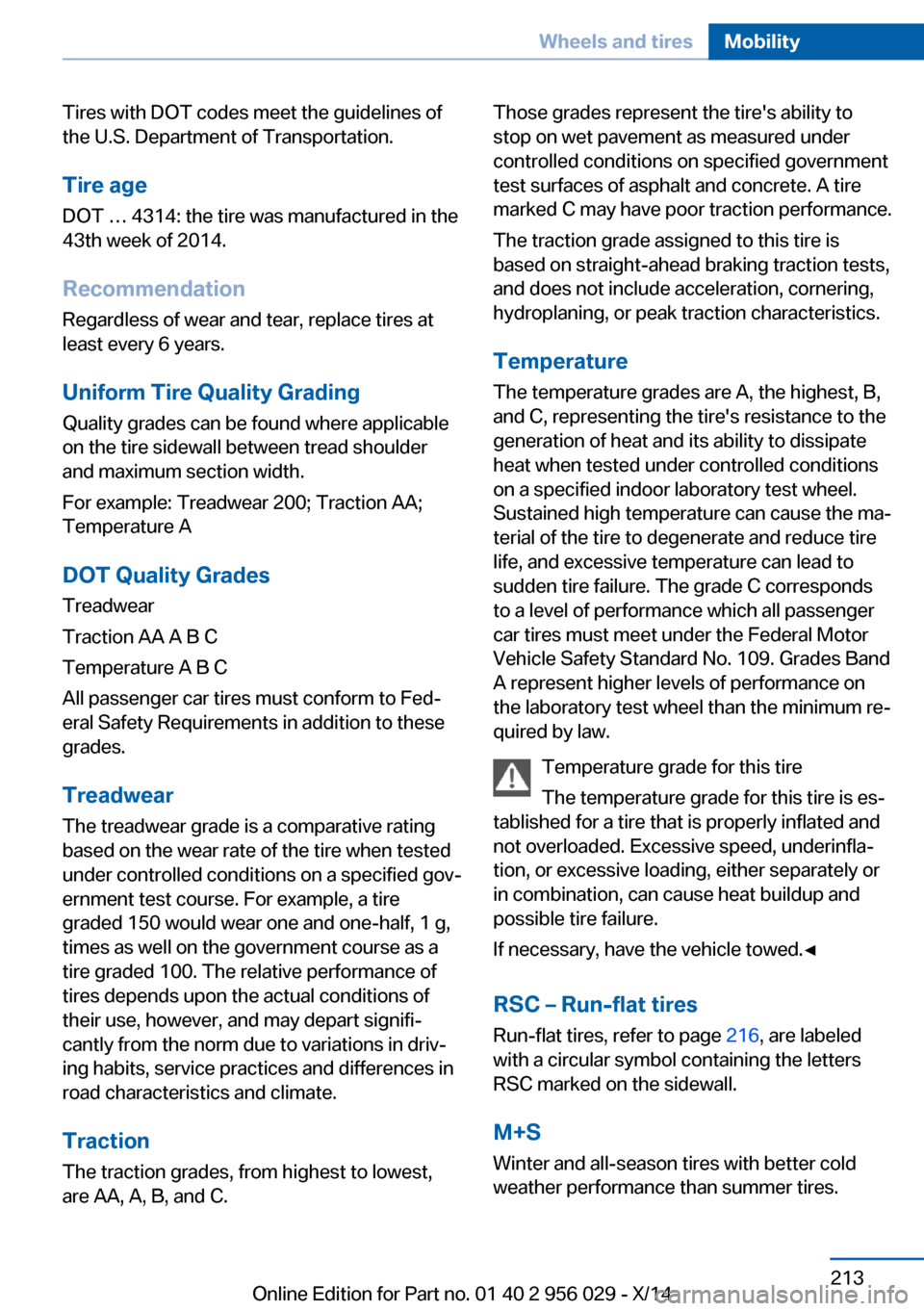
Tires with DOT codes meet the guidelines of
the U.S. Department of Transportation.
Tire age DOT … 4314: the tire was manufactured in the
43th week of 2014.
Recommendation
Regardless of wear and tear, replace tires at
least every 6 years.
Uniform Tire Quality Grading Quality grades can be found where applicable
on the tire sidewall between tread shoulder
and maximum section width.
For example: Treadwear 200; Traction AA;
Temperature A
DOT Quality Grades Treadwear
Traction AA A B C
Temperature A B C
All passenger car tires must conform to Fed‐
eral Safety Requirements in addition to these
grades.
TreadwearThe treadwear grade is a comparative rating
based on the wear rate of the tire when tested
under controlled conditions on a specified gov‐
ernment test course. For example, a tire
graded 150 would wear one and one-half, 1 g,
times as well on the government course as a
tire graded 100. The relative performance of
tires depends upon the actual conditions of
their use, however, and may depart signifi‐
cantly from the norm due to variations in driv‐
ing habits, service practices and differences in
road characteristics and climate.
Traction
The traction grades, from highest to lowest,
are AA, A, B, and C.Those grades represent the tire's ability to
stop on wet pavement as measured under
controlled conditions on specified government
test surfaces of asphalt and concrete. A tire
marked C may have poor traction performance.
The traction grade assigned to this tire is
based on straight-ahead braking traction tests,
and does not include acceleration, cornering,
hydroplaning, or peak traction characteristics.
Temperature
The temperature grades are A, the highest, B,
and C, representing the tire's resistance to the
generation of heat and its ability to dissipate
heat when tested under controlled conditions
on a specified indoor laboratory test wheel.
Sustained high temperature can cause the ma‐
terial of the tire to degenerate and reduce tire
life, and excessive temperature can lead to
sudden tire failure. The grade C corresponds
to a level of performance which all passenger
car tires must meet under the Federal Motor
Vehicle Safety Standard No. 109. Grades Band
A represent higher levels of performance on
the laboratory test wheel than the minimum re‐
quired by law.
Temperature grade for this tire
The temperature grade for this tire is es‐
tablished for a tire that is properly inflated and
not overloaded. Excessive speed, underinfla‐
tion, or excessive loading, either separately or
in combination, can cause heat buildup and
possible tire failure.
If necessary, have the vehicle towed.◀
RSC – Run-flat tires
Run-flat tires, refer to page 216, are labeled
with a circular symbol containing the letters RSC marked on the sidewall.
M+S
Winter and all-season tires with better cold
weather performance than summer tires.Seite 213Wheels and tiresMobility213
Online Edition for Part no. 01 40 2 956 029 - X/14
Page 220 of 265
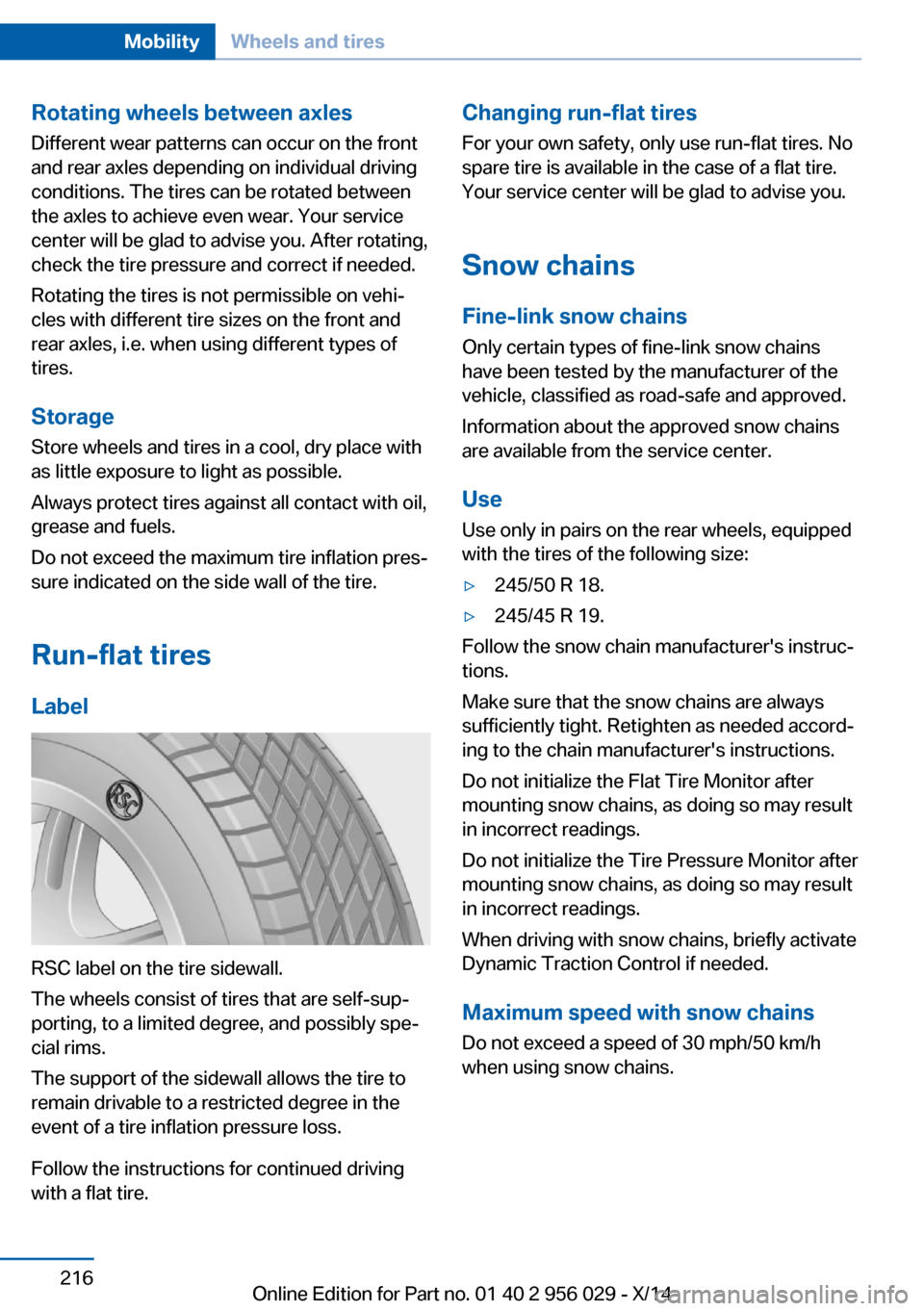
Rotating wheels between axlesDifferent wear patterns can occur on the frontand rear axles depending on individual driving
conditions. The tires can be rotated between
the axles to achieve even wear. Your service
center will be glad to advise you. After rotating,
check the tire pressure and correct if needed.
Rotating the tires is not permissible on vehi‐
cles with different tire sizes on the front and
rear axles, i.e. when using different types of
tires.
Storage
Store wheels and tires in a cool, dry place with
as little exposure to light as possible.
Always protect tires against all contact with oil,
grease and fuels.
Do not exceed the maximum tire inflation pres‐
sure indicated on the side wall of the tire.
Run-flat tires
Label
RSC label on the tire sidewall.
The wheels consist of tires that are self-sup‐
porting, to a limited degree, and possibly spe‐
cial rims.
The support of the sidewall allows the tire to
remain drivable to a restricted degree in the
event of a tire inflation pressure loss.
Follow the instructions for continued driving
with a flat tire.
Changing run-flat tires
For your own safety, only use run-flat tires. No
spare tire is available in the case of a flat tire.
Your service center will be glad to advise you.
Snow chains
Fine-link snow chains
Only certain types of fine-link snow chains
have been tested by the manufacturer of the
vehicle, classified as road-safe and approved.
Information about the approved snow chains
are available from the service center.
Use
Use only in pairs on the rear wheels, equipped
with the tires of the following size:▷245/50 R 18.▷245/45 R 19.
Follow the snow chain manufacturer's instruc‐
tions.
Make sure that the snow chains are always
sufficiently tight. Retighten as needed accord‐
ing to the chain manufacturer's instructions.
Do not initialize the Flat Tire Monitor after
mounting snow chains, as doing so may result
in incorrect readings.
Do not initialize the Tire Pressure Monitor after
mounting snow chains, as doing so may result
in incorrect readings.
When driving with snow chains, briefly activate
Dynamic Traction Control if needed.
Maximum speed with snow chains Do not exceed a speed of 30 mph/50 km/hwhen using snow chains.
Seite 216MobilityWheels and tires216
Online Edition for Part no. 01 40 2 956 029 - X/14
Page 256 of 265
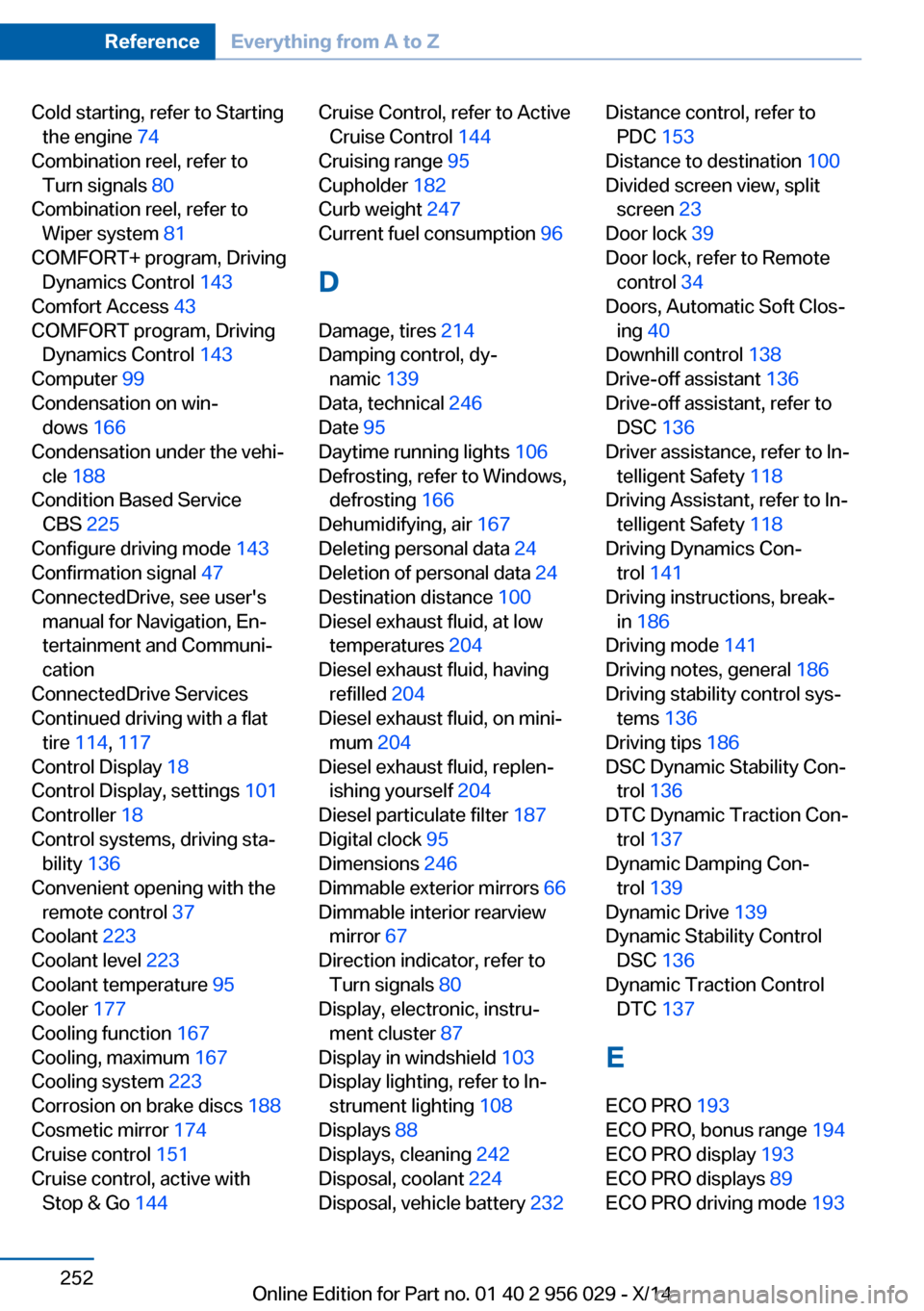
Cold starting, refer to Startingthe engine 74
Combination reel, refer to Turn signals 80
Combination reel, refer to Wiper system 81
COMFORT+ program, Driving Dynamics Control 143
Comfort Access 43
COMFORT program, Driving Dynamics Control 143
Computer 99
Condensation on win‐ dows 166
Condensation under the vehi‐ cle 188
Condition Based Service CBS 225
Configure driving mode 143
Confirmation signal 47
ConnectedDrive, see user's manual for Navigation, En‐
tertainment and Communi‐
cation
ConnectedDrive Services
Continued driving with a flat tire 114 , 117
Control Display 18
Control Display, settings 101
Controller 18
Control systems, driving sta‐ bility 136
Convenient opening with the remote control 37
Coolant 223
Coolant level 223
Coolant temperature 95
Cooler 177
Cooling function 167
Cooling, maximum 167
Cooling system 223
Corrosion on brake discs 188
Cosmetic mirror 174
Cruise control 151
Cruise control, active with Stop & Go 144 Cruise Control, refer to Active
Cruise Control 144
Cruising range 95
Cupholder 182
Curb weight 247
Current fuel consumption 96
D
Damage, tires 214
Damping control, dy‐ namic 139
Data, technical 246
Date 95
Daytime running lights 106
Defrosting, refer to Windows, defrosting 166
Dehumidifying, air 167
Deleting personal data 24
Deletion of personal data 24
Destination distance 100
Diesel exhaust fluid, at low temperatures 204
Diesel exhaust fluid, having refilled 204
Diesel exhaust fluid, on mini‐ mum 204
Diesel exhaust fluid, replen‐ ishing yourself 204
Diesel particulate filter 187
Digital clock 95
Dimensions 246
Dimmable exterior mirrors 66
Dimmable interior rearview mirror 67
Direction indicator, refer to Turn signals 80
Display, electronic, instru‐ ment cluster 87
Display in windshield 103
Display lighting, refer to In‐ strument lighting 108
Displays 88
Displays, cleaning 242
Disposal, coolant 224
Disposal, vehicle battery 232 Distance control, refer to
PDC 153
Distance to destination 100
Divided screen view, split screen 23
Door lock 39
Door lock, refer to Remote control 34
Doors, Automatic Soft Clos‐ ing 40
Downhill control 138
Drive-off assistant 136
Drive-off assistant, refer to DSC 136
Driver assistance, refer to In‐ telligent Safety 118
Driving Assistant, refer to In‐ telligent Safety 118
Driving Dynamics Con‐ trol 141
Driving instructions, break- in 186
Driving mode 141
Driving notes, general 186
Driving stability control sys‐ tems 136
Driving tips 186
DSC Dynamic Stability Con‐ trol 136
DTC Dynamic Traction Con‐ trol 137
Dynamic Damping Con‐ trol 139
Dynamic Drive 139
Dynamic Stability Control DSC 136
Dynamic Traction Control DTC 137
E ECO PRO 193
ECO PRO, bonus range 194
ECO PRO display 193
ECO PRO displays 89
ECO PRO driving mode 193 Seite 252ReferenceEverything from A to Z252
Online Edition for Part no. 01 40 2 956 029 - X/14
Page 262 of 265

Socket, OBD Onboard Diag‐nostics 225
Soot particulate filter 187
SOS button 234
Spare fuse 233
Speaker lighting 109
Specified engine oil types 222
Speed, average 100
Speed limit detection, com‐ puter 100
Speed limiter, display 97
Speed Limit Information 97
Speed warning 101
Split screen 23
SPORT+ - program, Dynamic Driving Control 142
Sport displays, torque dis‐ play, performance dis‐
play 101
SPORT program, driving dy‐ namics 142
Sport program, transmis‐ sion 85
Stability control systems 136
Start/stop, automatic func‐ tion 75
Start/Stop button 73
Start function during malfunc‐ tion 35
Starting the engine 74
Status control display, tires 115
Status information, iDrive 22
Status of Owner's Manual 6
Steering, Integral Active Steering 140
Steering wheel, adjusting 67
Steering wheel heating 68
Steering wheel memory 64
Steptronic Sport transmis‐ sion 86
Steptronic transmission 84
Stopping the engine 74
Storage compartments 180 Storage compartments, loca‐
tions 180
Storage, tires 216
Storing the vehicle 242
Summer tires, tread 214
Sun visor 174
Supplementary text mes‐ sage 93
Surround View 155
Suspension settings 141
Switch for Dynamic Driving Control 141
Switch-on times, parked-car ventilation 171
Switch, refer to Cockpit 14
Symbols 6
Symbols in the status field 22
SYNC program, automatic cli‐ mate control 167
T Tachometer 94
Tail and brake lights 230
Tail lights 230
Tail lights, bulb replace‐ ment 230
Technical changes, refer to Safety 7
Technical data 246
Telephone, see user's manual for Navigation, Entertain‐
ment and Communication
Temperature, automatic cli‐ mate control 166
Temperature display for ex‐ ternal temperature 95
Temperature, engine oil 94
Terminal, starting aid 236
Text message, supplemen‐ tary 93
Theft alarm system, refer to Alarm system 47
Theft protection, lug bolts 231 Thermal camera, see Night
Vision 127
Thigh support 55
Tilt alarm sensor 48
Time of arrival 100
Tire damage 214
Tire identification marks 212
Tire inflation pressure 207
Tire inflation pressure moni‐ tor, refer to FTM 113
Tire Pressure Monitor TPM 115
Tires, changing 214
Tires, everything on wheels and tires 207
Tires, run-flat tires 216
Tire tread 214
Tone, see user's manual for Navigation, Entertainment
and Communication
Tool 227
Top View 159
Total vehicle weight 247
Touchpad 21
Tow fitting 238
Towing 237
Tow lug, see tow fitting 238
Tow-starting 237
TPM Tire Pressure Moni‐ tor 115
Traction control 137
TRACTION, driving dynam‐ ics 137
TRACTION program, Dy‐ namic Driving Control 142
Transmission lock, electronic unlocking 86
Transmission, see Steptronic transmission 84
Transporting children safely 69
Tread, tires 214
Trip computer 100
Triple turn signal activa‐ tion 80
Trip odometer 95 Seite 258ReferenceEverything from A to Z258
Online Edition for Part no. 01 40 2 956 029 - X/14